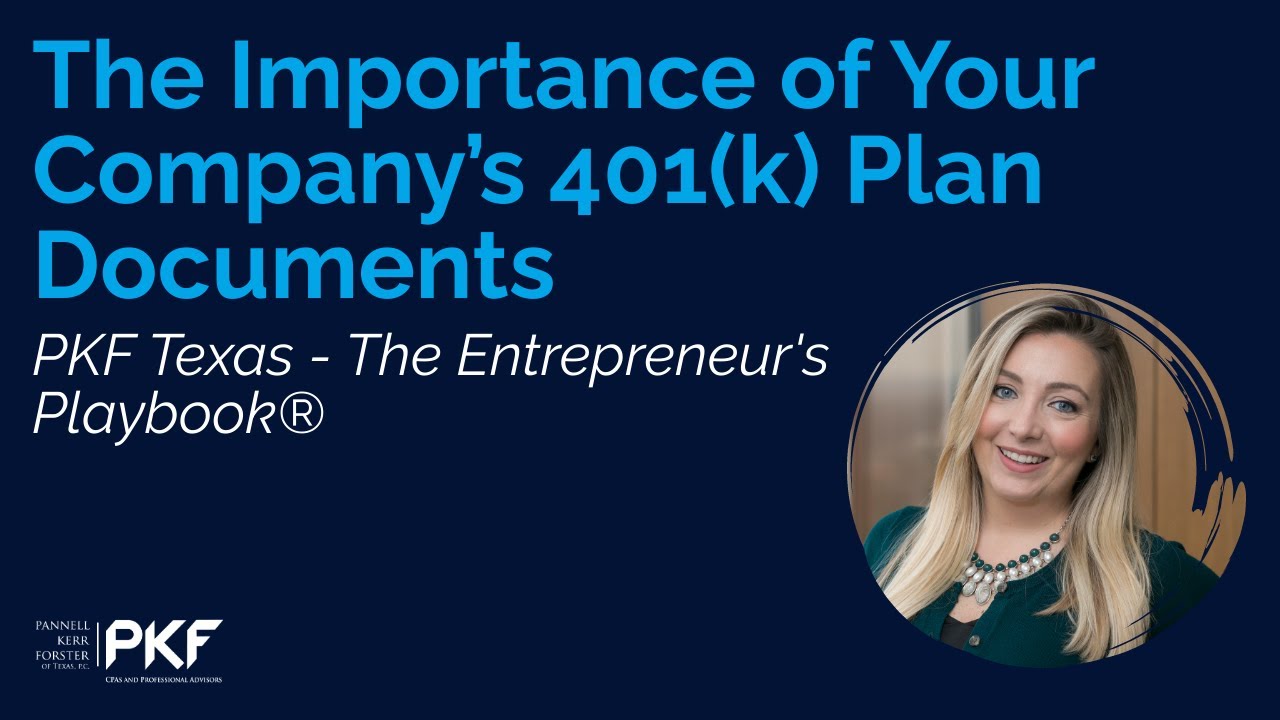The Importance of Your Company’s 401(k) Plan Documents

Jen Lemanski: This is the PKF Texas – Entrepreneur’s Playbook®. I’m Jen Lemanski, and I’m here with Jen Edmiston, an audit senior manager and a member of our employee benefit plan audit team. Jen, welcome to the Playbook.
Jen Edmiston: Thanks for having me.
Jen Lemanski: So EBPs… I know you get a ton of questions, but you know, one thing that I’m wondering is when you’re discussing 401(k) plans, you hear a lot of reference to plan documents and adoption agreements. Can you help the audience understand a little bit more about how these items relate to the operations of a 401(k) plan?
Jen Edmiston: So, when you participate in a prototype or volume submitter plan, which are typically offered through plan providers, like Fidelity, Mass Mutual, or Prudential, there are two main plan documents that govern the plan, and those are the basic plan document and the adoption agreement.
So, the basic plan document is essentially the core of the plan. That’s the document that gets submitted to the IRS for approval to be a qualified plan under the IRS. That document is fairly large. It’s rather legal and regulatory in nature, but that document contains all of the non-elective provisions of the plan.
The adoption agreement is what is provided to each plan sponsor to, from there, make their specific elections to tailor the plan to meet their needs. So, as you go through the adoption agreement, you will be able to make certain elections under things like eligibility, compensation, the matching formula, vesting, and so on. When you go through the adoption agreement, you’ll see references to the basic plan document, and that’s where you’ll find more information. So, as an example, when you’re looking at the adoption agreement and you see compensation, you can then see the reference back to the basic plan document, where you can find the legal definition of certain things like W-2 wages, 3401(a) wages, or Section 415 wages.
Jen Lemanski: So, Jen, can you give us an example of the importance of elections made in the adoption agreement and how they relate to the audit work plan compliance?
Jen Edmiston: Yeah. So, if you’ve been through an audit before, you know that typically issues come up with things like compensation, eligibility, vesting, and so on. Those are all the items that the plan sponsor is electing in their adoption agreement.
So, for example, let’s take compensation, and let’s say that in the plan document, in the adoption agreement, the plan sponsor has elected W-2 wages, but they would like to exclude bonuses. During the audit procedures, we go through and we test that compensation through reviewing payroll records for our selected employees. If we find that, for example, the payroll system is not classifying bonuses correctly, for example, they’re including them rather than exploiting them, that is a plan compliance issue. So, it’s really important to make sure that your payroll system, in this case, is aligned with the plan document.
Jen Lemanski: Well, that sounds great. So, what should plan sponsors be doing to minimize their compliance risk in this area?
Jen Edmiston: So, what I would recommend plan sponsors to do is to sit down and take a thorough look at their plan document, make sure that they understand all of the terms in the basic plan document and the adoption agreement, because those elections govern their plan.
The next thing they want to do is make sure that the operations of their plan, whether that be through the payroll department or the HR department, are in alignment with those elections in the plan document. So, as I mentioned before with compensation, there is a potential for the coding and the payroll system to not be in alignment with the elections and the adoption agreement. Now, something that would be common for this mistake here would be that let’s say the plan sponsor and the person in charge of the plan, essentially at the plan sponsor, submits a submitted amendment. And in that amendment, there is a slight change to the definition of compensation. That may not be communicated effectively to the payroll department, and so, they don’t know to review the payroll codes and change that code to eligible or ineligible. The opposite could be true. The payroll department could add a new type of pay code, not being in communication with the HR department or the plan administrator, whoever that is, to really understand: should that be a pay code, be classified correctly as eligible or non-eligible compensation.
So, really, it’s about taking the time to sit down, understand your plan, and then make sure that the actual day-to-day operations at the plan sponsor align with those elections. As I mentioned, the basic plan document is very legal and regulatory in nature, and therefore some of these definitions and some of these items are really hard to understand. And in that case, we usually recommend that you reach out to your ERISA council so that they can give you the guidance you need to make sure that your plan is operating in accordance with the provisions that you’ve elected.
Now, obviously if you need more information or you have a question you can always reach out to us. We obviously have a lot of knowledge in this area as well.
Jen Lemanski: That’s perfect. And one final question is for, you know, company size, usually it’s what a hundred employees when it kicks them over to needing an audit of their plan, or should they be calling you when they have about 90?
Jen Edmiston: Well, this is a really tricky rule, and it confuses a lot of people. So, the rule is actually if your plan has never gone over 120 eligible participants before, 120 is your limit. Now, eligible participants is the key here – not employees, not participating participants – so sometimes you think just those people that are contributing to the plan, no; this is anybody who’s eligible to participate in the plan. So, I would say, even as you approach the 100-employee mark, you start considering these things and recognizing when your plan may need an audit.
Jen Lemanski: Perfect. Well, we’ll get you back to talk about this some more. Sound good?
Jen Edmiston: Sounds good.
Jen Lemanski: This has been another thought leadership production brought to you by PKF Texas – The Entrepreneurs Playbook®. For more information about employee benefit plans, visit www.pkftexas.com/BenefitPlanAudits. Tune in next week for another chapter.

